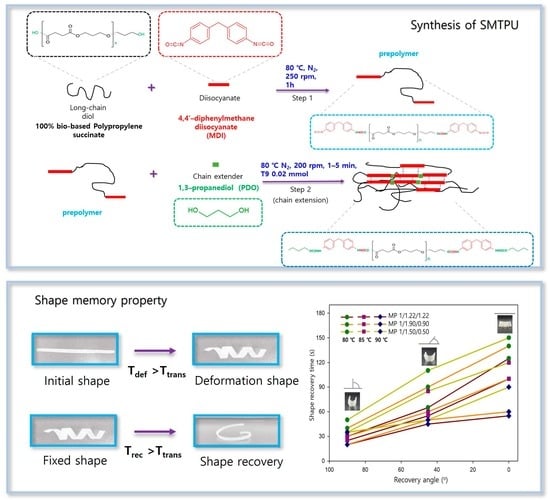Synthesis of Novel Shape Memory Thermoplastic Polyurethanes (SMTPUs) from Bio-Based Materials for Application in 3D/4D Printing Filaments
Abstract
:1. Introduction
2. Materials and Methods
2.1. Materials
2.2. Synthesis of the Bio-Based Shape Memory Thermoplastic Polyurethanes
2.3. Preparation of the Bio-Based Shape Memory Thermoplastic Polyurethanes Filaments
2.4. D Fused Deposition Modeling (FDM) Printing of Shape Memory Thermoplastic Polyurethanes Filaments
2.5. Characterization
2.5.1. Chemical Structures, Morphologies, and Crystalline Analyses of the Bio-Based Shape Memory Thermoplastic Polyurethane Films
2.5.2. Mechanical and Thermal Analyses of the Bio-Based Shape Memory Thermoplastic Polyurethane Films
2.5.3. Characterization of the Bio-Based Shape Memory Thermoplastic Polyurethane Filaments
2.5.4. Characterization of the Shape Memory Properties
2.5.5. Shape Memory Behaviors of the 3D-Printed SMTPUs
3. Results and Discussion
3.1. Characterization of the Chemical Structures of the SMTPU Films
3.2. Morphology and Crystalline Properties
3.3. Thermal Analysis
3.3.1. Differential Scanning Calorimetry (DSC)
3.3.2. Dynamic Mechanical Analysis (DMA)
3.3.3. Thermogravimetric Analysis (TGA)
3.4. Mechanical Properties
3.5. Fabrication of the Bio-Based SMTPU Filaments
3.6. Shape Recovery Properties
3.6.1. Shape Fixing and Recovery Properties of the Bio-Based SMTPU Films
3.6.2. Shape Fixing and Recovery of Bio-Based 3D-Printed SMTPUs
4. Conclusions
Supplementary Materials
Author Contributions
Funding
Institutional Review Board Statement
Informed Consent Statement
Data Availability Statement
Conflicts of Interest
References
- Liu, F.; Urban, M.W. Recent advances and challenges in designing stimuli-responsive polymers. Prog. Polym. Sci. 2010, 35, 3–23. [Google Scholar] [CrossRef]
- Urban, M.W. Stimuli-Responsive Materials: From Molecules to Nature Mimicking Materials Design; Royal Society of Chemistry: London, UK, 2016. [Google Scholar]
- Lendlein, A.; Langer, R. Biodegradable, elastic shape-memory polymers for potential biomedical applications. Science 2002, 296, 1673–1676. [Google Scholar] [CrossRef] [PubMed]
- Lendlein, A.; Kelch, S. Shape-memory polymers. Angew. Chem. Int. Ed. 2002, 41, 2034–2057. [Google Scholar] [CrossRef]
- Komez, A.; Buyuksungur, S.; Hasirci, V.; Hasirci, N. Effect of chemical structure on properties of polyurethanes: Temperature responsiveness and biocompatibility. J. Bioact. Compat. Polym. 2018, 33, 479–497. [Google Scholar] [CrossRef]
- Mather, P.T.; Luo, X.; Rousseau, I.A. Shape memory polymer research. Annu. Rev. Mater. Res. 2009, 39, 445–471. [Google Scholar] [CrossRef]
- Lendlein, A.; Behl, M.; Hiebl, B.; Wischke, C. Shape-memory polymers as a technology platform for biomedical applications. Expert Rev. Med. Devices 2010, 7, 357–379. [Google Scholar] [CrossRef] [Green Version]
- Rousseau, I.A. Challenges of shape memory polymers: A review of the progress toward overcoming SMP’s limitations. Polym. Eng. Sci. 2008, 48, 2075–2089. [Google Scholar] [CrossRef]
- Shin, E.J.; Park, Y.; Jung, Y.S.; Choi, H.Y.; Lee, S. Fabrication and characteristics of flexible thermoplastic polyurethane filament for fused deposition modeling three-dimensional printing. Polym. Eng. Sci. 2022, 62, 2947–2957. [Google Scholar] [CrossRef]
- Li, F.; Chen, Y.; Zhu, W.; Zhang, X.; Xu, M. Shape memory effect of polyethylene/nylon 6 graft copolymers. Polymer 1998, 39, 6929–6934. [Google Scholar] [CrossRef]
- Heijkants, R.G.; van Calck, R.V.; van Tienen, T.G.; de Groot, J.H.; Buma, P.; Pennings, A.J.; Schouten, A.J. Uncatalyzed synthesis, thermal and mechanical properties of polyurethanes based on poly (ε-caprolactone) and 1, 4-butane diisocyanate with uniform hard segment. Biomaterials 2005, 26, 4219–4228. [Google Scholar] [CrossRef] [Green Version]
- Neuss, S.; Blomenkamp, I.; Stainforth, R.; Boltersdorf, D.; Jansen, M.; Butz, N.; Knüchel, R. The use of a shape-memory poly (ε-caprolactone) dimethacrylate network as a tissue engineering scaffold. Biomaterials 2009, 30, 1697–1705. [Google Scholar] [CrossRef] [PubMed]
- Zeng, B.; Cao, M.; Shen, J.; Yang, K.; Zheng, Y.; Guo, S. Tuning the dual-and triple-shape-memory effect of thermoplastic polyurethane/polylactic acid/poly (propylene carbonate) ternary blends via morphology control. Polymer 2022, 242, 124546. [Google Scholar] [CrossRef]
- Lin, J.; Chen, L. Study on shape-memory behavior of polyether-based polyurethanes. I. Influence of the hard-segment content. J. Appl. Polym. Sci. 1998, 69, 1563–1574. [Google Scholar] [CrossRef]
- Qi, X.; Xiu, H.; Wei, Y.; Zhou, Y.; Guo, Y.; Huang, R. Enhanced shape memory property of polylactide/thermoplastic poly (ether) urethane composites via carbon black self-networking induced co-continuous structure. Compos. Sci. Technol. 2017, 139, 8–16. [Google Scholar] [CrossRef]
- Xu, S.; Zhao, B.; Wei, K.; Zheng, S. Organic–Inorganic Polyurethanes with Double Decker Silsesquioxanes in the Main Chains: Morphologies, Surface Hydrophobicity, and Shape Memory Properties. J. Polym. Sci. Part B Polym. Phys. 2018, 56, 893–906. [Google Scholar] [CrossRef]
- Hasirci, N.; Ayse Aksoy, E. Synthesis and Modifications of Polyurethanes for Biomedical Purposes. High Perform. Polym. 2007, 19, 621–637. [Google Scholar] [CrossRef]
- Xu, Z.; Cui, Y.; Li, T.; Dang, H.; Li, J.; Cheng, F. Enhanced Mechanical and Shape Memory Properties of Poly(Propylene Glycol)-Based Star-Shaped Polyurethane. Macromol. Chem. Phys. 2020, 221, 2000082. [Google Scholar] [CrossRef]
- Peng, F.; Yang, X.; Zhu, Y.; Wang, G. Effect of the Symmetry of Polyether Glycols on Structure-Morphology-Property Behavior of Polyurethane Elastomers. Polymer 2022, 239, 124429. [Google Scholar] [CrossRef]
- Candau, N.; Stoclet, G.; Tahon, J.F.; Demongeot, A.; Yilgor, E.; Yilgor, I.; Oguz, O. Mechanical reinforcement and memory effect of strain-induced soft segment crystals in thermoplastic polyurethane-urea elastomers. Polymer 2021, 223, 123708. [Google Scholar] [CrossRef]
- Lai, S.M.; You, P.Y.; Chiu, Y.T.; Kuo, C.W. Triple-shape memory properties of thermoplastic polyurethane/olefin block copolymer/polycaprolactone blends. J. Polym. Res. 2017, 24, 161. [Google Scholar] [CrossRef]
- Calvo-Correas, T.; Gabilondo, N.; Alonso-Varona, A.; Palomares, T.; Corcuera, M.A.; Eceiza, A. Shape-memory properties of crosslinked biobased polyurethanes. Eur. Polym. J. 2016, 78, 253–263. [Google Scholar] [CrossRef]
- Gopinath, A.; Subaraja, M.; Nasar, A.S. Fluorescent shape-memory hyperbranched polyurethanes: Synthesis, characterization and evaluation of cytotoxicity. Eur. Polym. J. 2018, 108, 517–528. [Google Scholar] [CrossRef]
- Gorbunova, M.A.; Anokhin, D.V.; Badamshina, E.R. Recent Advances in the Synthesis and Application of Thermoplastic Semicrystalline Shape Memory Polyurethanes. Polym. Sci. Ser. B 2020, 62, 427–450. [Google Scholar] [CrossRef]
- Arévalo, F.R.; Osorio, S.A.; Valcárcel, N.A.; Ibarra, J.C.; Valero, M.F. Characterization and in vitro biocompatibility of binary mixtures of chitosan and polyurethanes synthesized from chemically modified castor oil, as materials for medical use. Polym. Renew. Resour. 2018, 9, 23–38. [Google Scholar] [CrossRef] [Green Version]
- Nguyen, T.T.; Kim, J. 4D-printing—Fused deposition modeling printing and PolyJet printing with shape memory polymers composite. Fibers Polym. 2020, 21, 2364–2372. [Google Scholar] [CrossRef]
- Bates, S.R.; Farrow, I.R.; Trask, R.S. 3D printed polyurethane honeycombs for repeated tailored energy absorption. Mater. Des. 2016, 112, 172–183. [Google Scholar] [CrossRef] [Green Version]
- Yap, H.K.; Ng, H.Y.; Yeow, C.-H. High-force soft printable pneumatics for soft robotic applications. Soft Rob. 2016, 3, 144–158. [Google Scholar] [CrossRef]
- Jia, H.; Huang, Z.Z.; Fei, P.J.; Dyson, Z.; Zheng, X. Wang Bilayered polyurethane/dipole-dipole and H-bonding interaction reinforced hydrogels as thermo-responsive soft manipulators. J. Mater. Chem. B 2017, 5, 8193–8199. [Google Scholar] [CrossRef]
- Ho, E.; Chen, Y.; Traore, Y.; Li, A.; Fowke, K. Development of polyether urethane intravaginal rings for the sustained delivery of hydroxychloroquine. Drug Des. Devel. Ther. 2014, 1801. [Google Scholar] [CrossRef] [Green Version]
- Kızıltay, A.; Fernandez, A.M.; Roman, J.S.; Hasirci, V.; Hasirci, N. Lysine Based Poly(ester-urethane) Films for Tissue Engineering Applications. J. Biomater. Tissue Eng. 2012, 2, 143–153. [Google Scholar] [CrossRef]
- Rahmatabadi, D.; Aberoumand, M.; Soltanmohammadi, K.; Soleyman, E.; Ghasemi, I.; Baniassadi, M.; Baghani, M. 4D Printing-Encapsulated Polycaprolactone–Thermoplastic Polyurethane with High Shape Memory Performances. Adv. Eng. Mater. 2022, 2201309. [Google Scholar] [CrossRef]
- Pei, E.; Loh, G.H. Technological considerations for 4D printing: An overview. Prog. Addit. Manuf. 2018, 3, 95–107. [Google Scholar] [CrossRef] [Green Version]
- Shin, E.J.; Jung, Y.S.; Choi, H.Y.; Lee, S. Synthesis and fabrication of biobased thermoplastic polyurethane filament for FDM 3D printing. J. Appl. Polym. Sci. 2022, 139, e52959. [Google Scholar] [CrossRef]
- Kim, H.D.; Huh, J.H.; Kim, E.Y.; Park, C.C. Comparison of properties of thermoplastic polyurethane elastomers with two different soft segments. J. Appl. Polym. Sci. 1998, 69, 1349–1355. [Google Scholar] [CrossRef]
- Chang, C.C.; Chen, K.S.; Yu, T.L.; Chen, Y.S.; Tsai, C.L.; Tseng, Y.H. Phase segregation of polyester based-polyurethanes. Polym. J. 1999, 31, 1205–1210. [Google Scholar] [CrossRef] [Green Version]
- Ryan, A.J.; Willkomm, W.R.; Bergstrom, T.B.; Macosko, C.W.; Koberstein, J.T.; Yu, C.C.; Russell, T.P. Dynamics of (Micro)phase separation during fast, bulk copolymerization: Some synchrotron SAXS experiments. Macromolecules 1991, 24, 2883–2889. [Google Scholar] [CrossRef]
- Lu, Y.; Xu, H.; Liang, N.; Xu, Z.; Chen, S.; Zhang, D. High Mechanical Strength of Shape-Memory Hyperbranched Epoxy Resins. ACS Appl. Polym. Mater. 2022, 4, 5574–5582. [Google Scholar] [CrossRef]
- Ping, P.; Wang, W.; Chen, X.; Jing, X. The influence of hard-segments on two-phase structure and shape memory properties of PCL-based segmented polyurethanes. J. Polym. Sci. Part B Polym. Phys. 2007, 45, 557–570. [Google Scholar] [CrossRef]
- Charlon, M.; Heinrich, B.; Matter, Y.; Couzigné, E.; Donnio, B.; Avérous, L. Synthesis, structure, and properties of fully biobased thermoplastic polyurethanes, obtained from a diisocyanate based on modified dimer fatty acids, and different renewable diols. Eur. Polym. J. 2014, 61, 197–205. [Google Scholar] [CrossRef]
- Li, J.-W.; Tsai, H.-A.; Lee, H.-T.; Cheng, Y.-H.; Chiu, C.-W.; Suen, M.-C. Synthesis and properties of side chain fluorinated polyurethanes and evaluation of changes in microphase separation. Prog. Org. Coat. 2020, 145, 105702. [Google Scholar] [CrossRef]
- Fernández-d’Arlas, B.; Rueda, L.; de la Caba, K.; Mondragon, I.; Eceiza, A. Microdomain composition and properties differences of biodegradable polyurethanes based on MDI and HDI. Polym. Eng. Sci. 2008, 48, 519–529. [Google Scholar] [CrossRef]
- Sung, C.S.P.; Schneider, N.S. Infrared studies of hydrogen bonding in toluene diisocyanate based polyurethanes. Macromolecules 1974, 8, 68–73. [Google Scholar] [CrossRef]
- Niemczyk, A.; Piegat, A.; Olalla, Á.S.; El Fray, M. New approach to evaluate microphase separation in segmented polyurethanes containing carbonate macrodiol. Eur. Polym. J. 2017, 93, 182–191. [Google Scholar] [CrossRef]
- Fuensanta, M.; Martín-Martínez, J.M. Structural and Viscoelastic Properties of Thermoplastic Polyurethanes Containing Mixed Soft Segments with Potential Application as Pressure Sensitive Adhesives. Polymers 2021, 13, 3097. [Google Scholar] [CrossRef] [PubMed]
- Janik, H. The size of cryofracture figures in the network of segmented polyurethane elastomers. Macromol. Symp. 2001, 171, 115–122. [Google Scholar] [CrossRef]
- Bajsic, E.G.; Rek, V.; Sendijarevic, A.; Sendijarevic, V.; Frisch, K.C. DSC study of morphological changes in segmented polyurethane elastomers. J. Elastom. Plast. 2000, 32, 163–182. [Google Scholar] [CrossRef]
- Seymour, R.W.; Cooper, S.L. Thermal analysis of polyurethane block polymers. Macromolecules 1973, 6, 48–53. [Google Scholar] [CrossRef]
- Koberstein, J.T.; Russell, T.P. Simultaneous SAXS-DSC study of multiple endothermic behaviour in polyether-based polyurethane block copolymers. Macromolecules 1986, 19, 714–720. [Google Scholar] [CrossRef]
- Saiani, A.; Daunch, W.A.; Verbeke, H.; Leenslag, J.W.; Higgins, J.S. Origin of multiple melting endotherms in a high hard block content polyurethane. 1. Thermodynamic investigation. Macromolecules 2001, 34, 9059–9068. [Google Scholar] [CrossRef]
- Sarkhosh, H.; Nourany, M.; Noormohammadi, F.; Ranjbar, H.A.; Zakizadeh, M.; Javadzadeh, M. Development of a semi-crystalline hybrid polyurethane nanocomposites for hMSCs cell culture and valuation of body-temperature shape memory performance and isothermal crystallization kinetics. Polym. Res. 2021, 28, 2201309. [Google Scholar] [CrossRef]
- Hablot, E.; Zheng, D.; Bouquey, M.; Avérous, L. Polyurethane based on castor oil: Kinetics, chemical, mechanical and thermal properties. Macromol. Mater. Eng. 2008, 293, 922–929. [Google Scholar] [CrossRef]
- Kong, X.; Narine, S.S. Physical properties of polyurethane plastic sheets produced from polyols from canola oil. Biomacromolecules 2007, 8, 2203–2209. [Google Scholar] [CrossRef] [PubMed]
- Qi, H.J.; Boyce, M.C. Stress-Strain Behavior of Thermoplastic Polyurethanes. Mech. Mater. 2005, 37, 817–839. [Google Scholar] [CrossRef]
- Buckley, C.P.; Prisacariu, C.; Martin, C. Elasticity and Inelasticity of Thermoplastic Polyurethane Elastomers: Sensitivity to Chemical and Physical Structure. Polymer 2010, 51, 3213–3224. [Google Scholar] [CrossRef]
- Wu, G.; Panahi-Sarmad, M.; Xiao, X.; Dong, K.; Mei, X.; Li, S.; Hou, X. Synthesis and Properties of Multistimuli Responsive Shape Memory Polyurethane Bioinspired from α-Keratin Hair. Adv. Mater. Technol. 2021, 6, 2001275. [Google Scholar] [CrossRef]
- Ahmad, M.; Luo, J.; Xu, B.; Purnawali, H.; King, P.J.; Chalker, P.; Fu, R.Y.; Huang, W.; Miraftab, M. Synthesis and characterization of polyurethane-based shape-memory polymers for tailored Tg around body temperature for medical applications. Macromol. Chem. Phys. 2011, 212, 592–602. [Google Scholar] [CrossRef]
- Smith, C.W.; Grima, J.N.; Evans, K.E. A novel mechanism for generating auxetic behaviour in reticulated foams: Missing rib foam model. Acta Mater. 2000, 48, 4349–4356. [Google Scholar] [CrossRef]
- Jiang, Y.Y.; Li, Y.N. Novel 3D-Printed Hybrid Auxetic Mechanical Metamaterial with Chirality-Induced Sequential Cell Opening Mechanisms. Adv. Eng. Mater. 2017, 1700744. [Google Scholar] [CrossRef]
- Milton, G.W. Complete characterization of the macroscopic deformations of periodic unimode metamaterials of rigid bars and pivots. J. Mech. Phys. Solids 2013, 61, 1543–1560. [Google Scholar] [CrossRef] [Green Version]
- Guiducci, L.; Fratzl, P.; Brechet, Y.J.M.; Dunlop, J.W.C. Pressurized honeycombs as soft-actuators: A theoretical study. J. R. Soc. Interface 2014, 11, 20140458. [Google Scholar] [CrossRef]
- Dolla, W.J.S.; Fricke, B.A.; Becker, B.R. Auxetic drug-eluting stent design. In Proceedings of the Frontiers in Biomedical Devices Conference, Irvine, CA, USA, 8–9 June 2006; pp. 11–12. [Google Scholar]
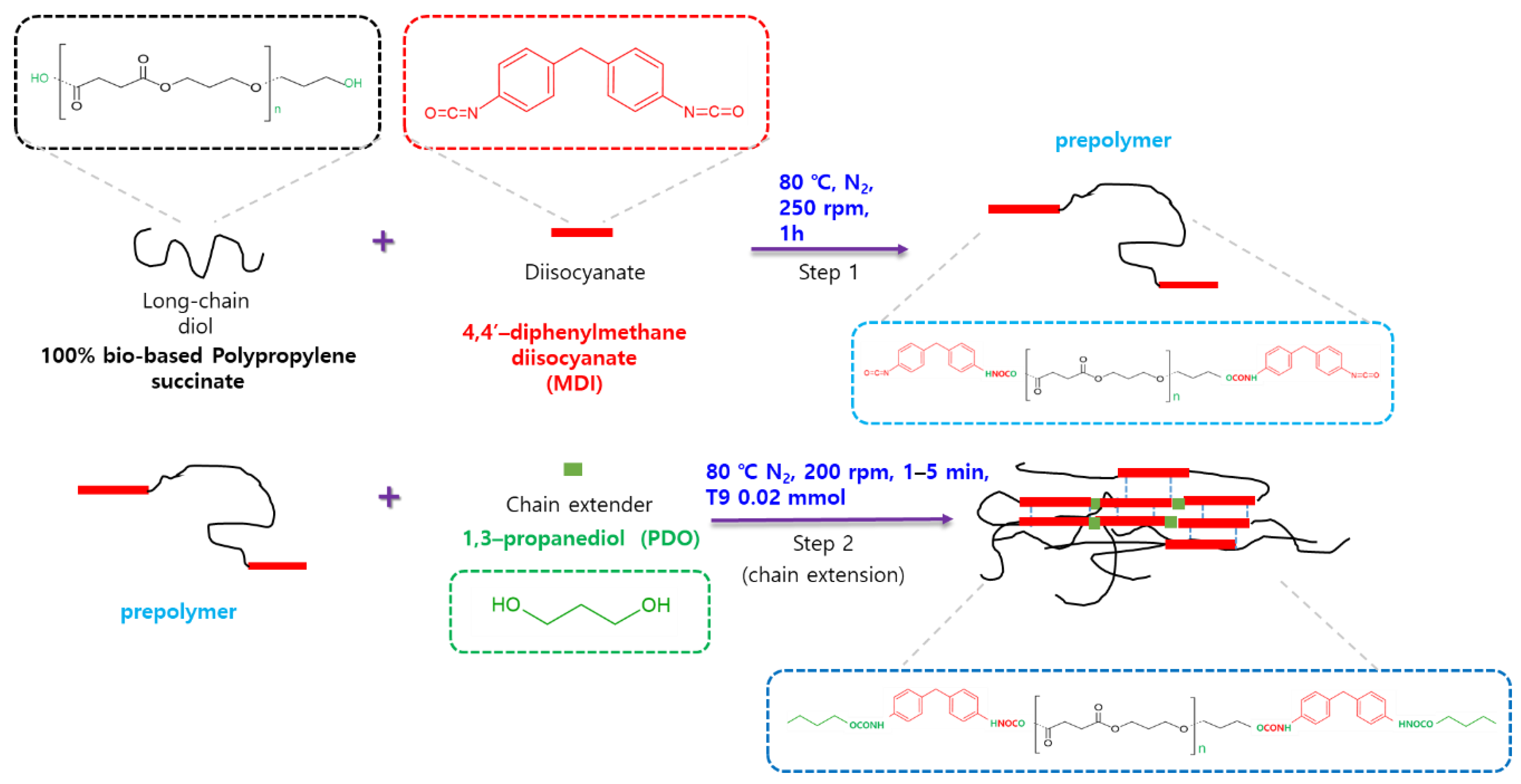

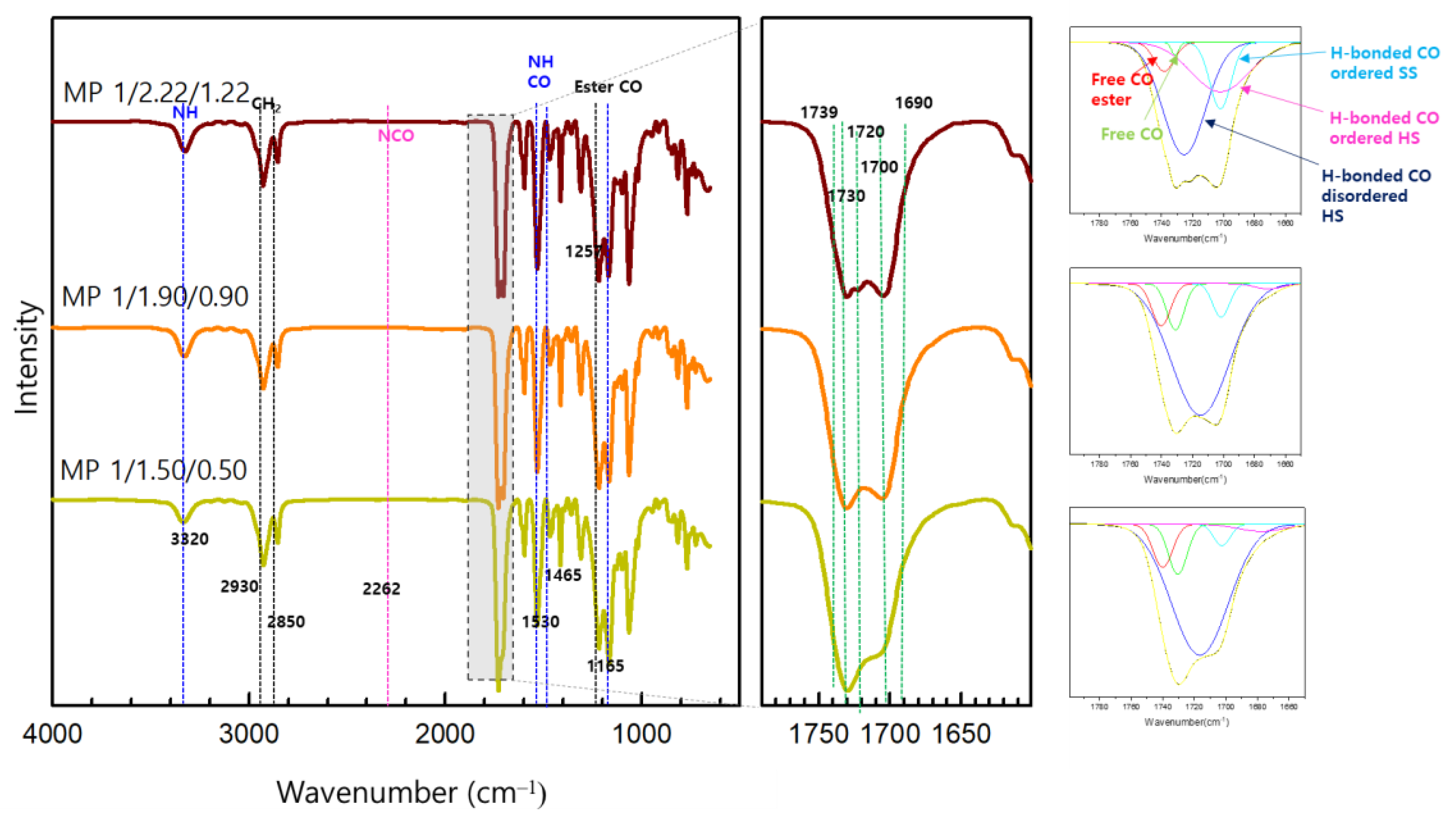

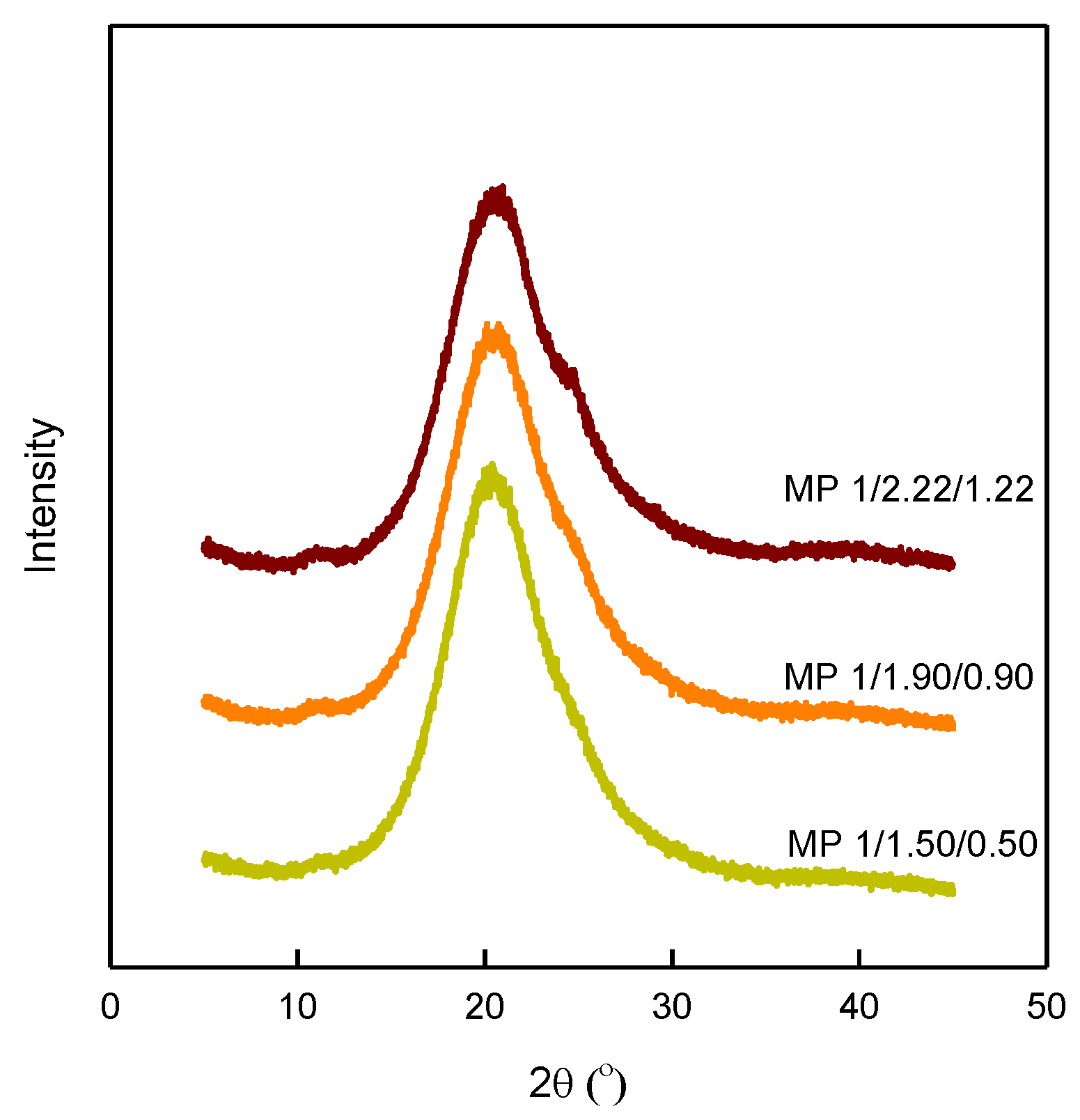
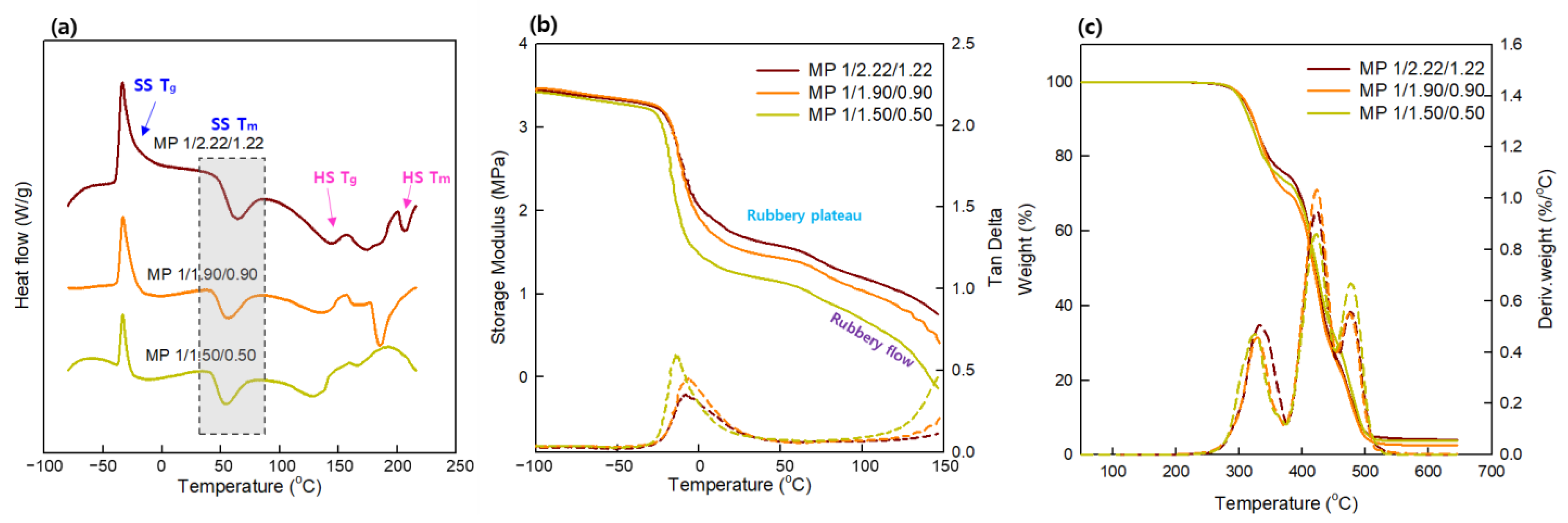
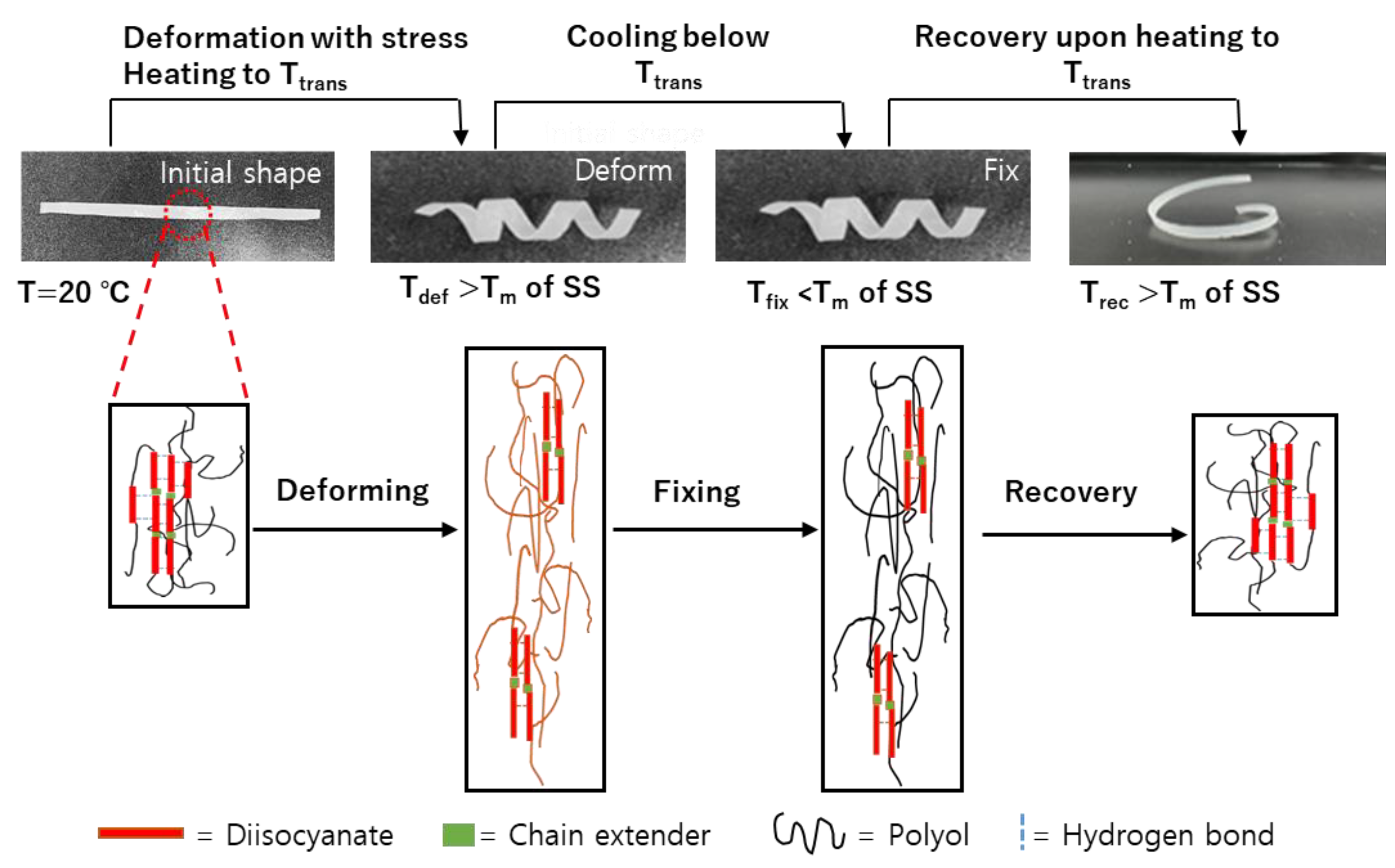
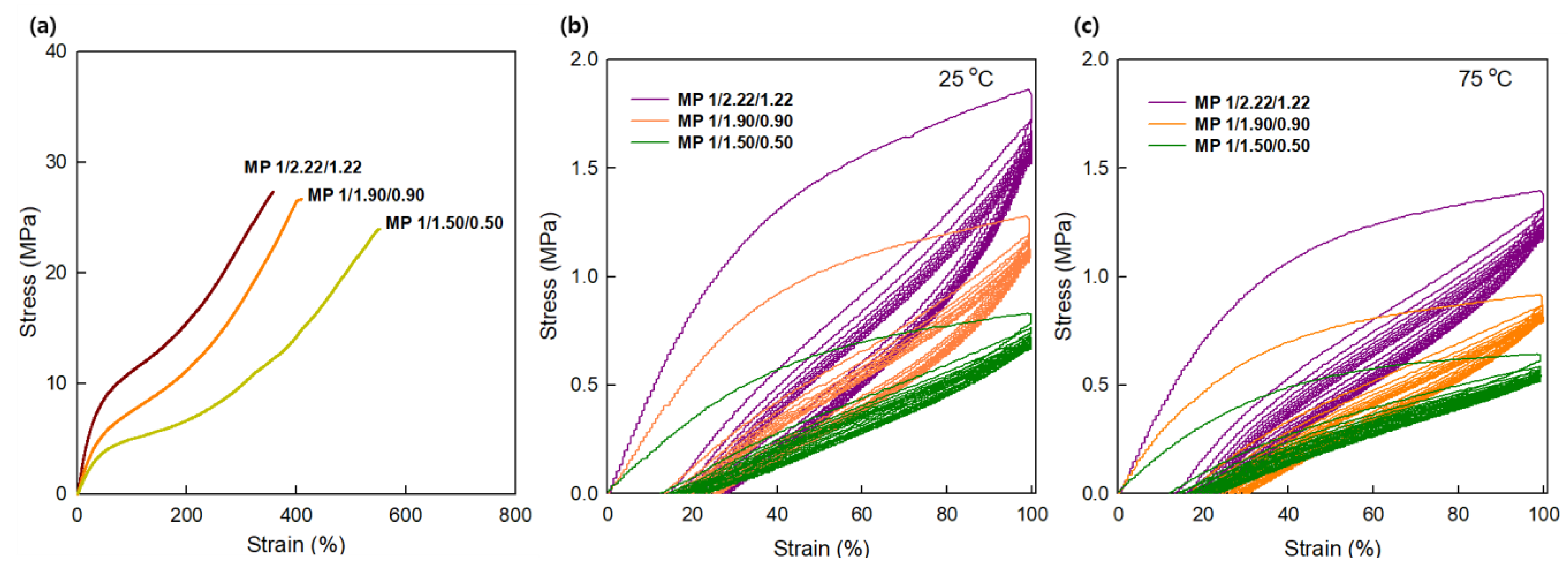
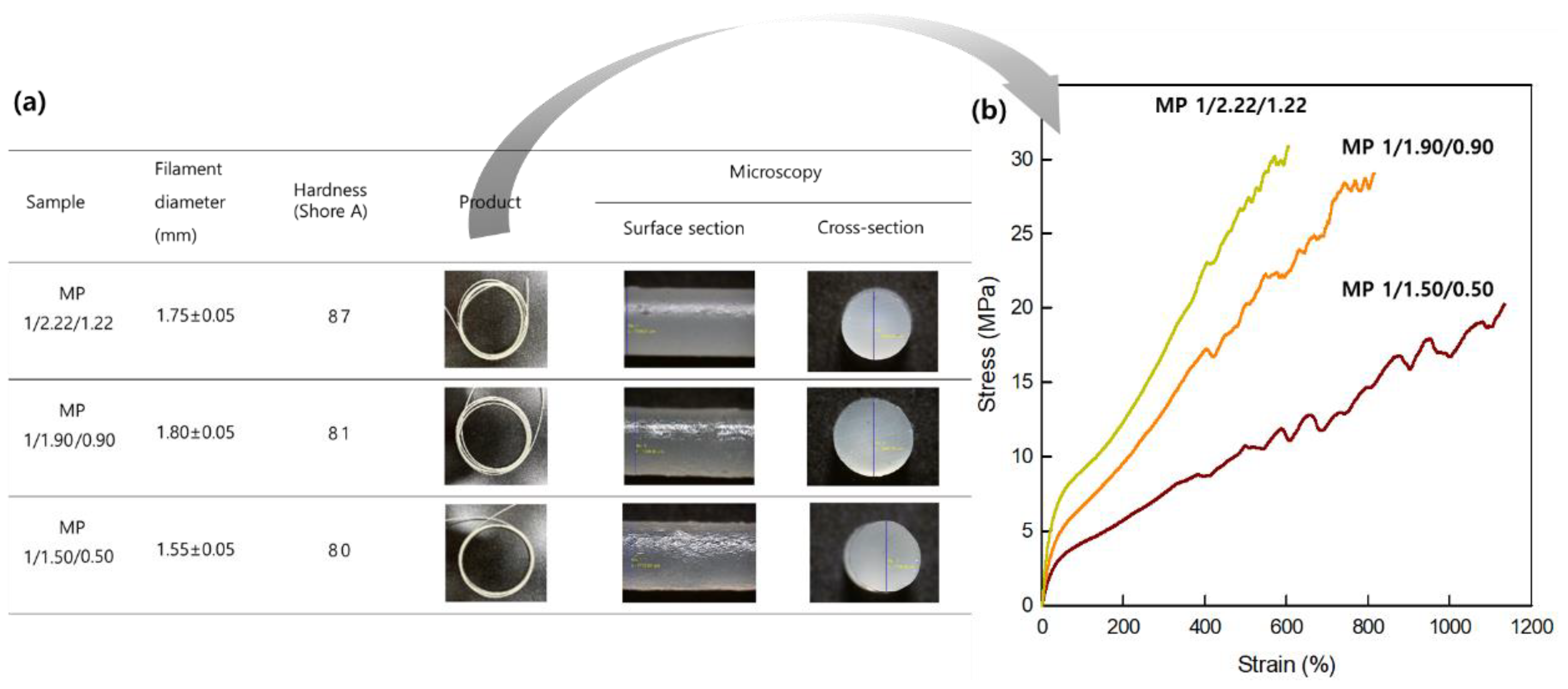
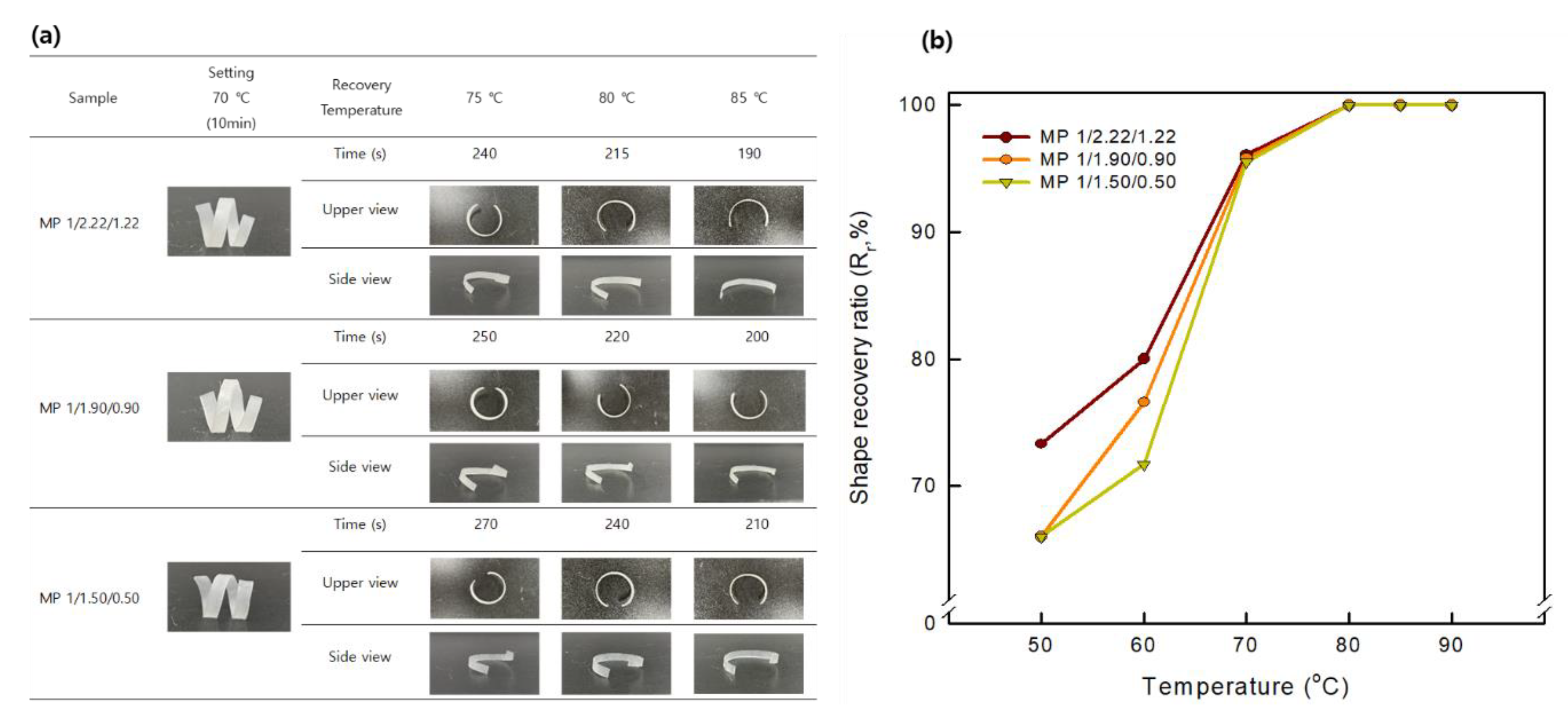

| Sample | NCO/OH | HS Content (wt%) a | Content of Bio-Based Sources (wt%) b |
|---|---|---|---|
| MP 1/2.22/1.22 | 1:1 | 39.3 | 66.3 |
| MP 1/1.90/0.90 | 35.2 | 69.2 | |
| MP 1/1.50/0.50 | 29.2 | 73.4 |
| Sample | Screw Temperature (°C) | Screw Speed (rpm) | Winding Position (cm) | Nozzle Diameter (mm) |
|---|---|---|---|---|
| MP 1/2.22/1.22 | 207 | 13.2 | 90 | 1.5 |
| MP 1/1.90/0.90 | 205 | 13.0 | 90 | 1.5 |
| MP 1/1.50/0.50 | 200 | 13.2 | 90 | 1.5 |
| Sample | Free C=O Ester in Soft Domain (%) 1739 cm−1 | Free C=O in Hard Domain (%) 1730 cm−1 | H-Bonded C=O in Disordered Hard Domain (%) 1720 cm−1 | H-Bonded C=O in Ordered Hard Domain (%) 1700 cm−1 | H-Bonded C=O in Disordered Soft Domain (%) 1690 cm−1 | Xb |
|---|---|---|---|---|---|---|
| MP 1/2.22/1.22 | 13.5 | 5.0 | 28.5 | 39.0 | 14.2 | 0.92 |
| MP 1/1.90/0.90 | 13.8 | 11.6 | 35.8 | 18.7 | 20.2 | 0.80 |
| MP 1/1.50/0.50 | 12.4 | 11.9 | 36.2 | 10.5 | 29.0 | 0.77 |
| Items | f | Xb | W′2 | MP | SP | HP |
|---|---|---|---|---|---|---|
| Sample | ||||||
| MP 1/2.22/1.22 | 0.39 | 0.92 | 0.05 | 0.02 | 0.63 | 0.37 |
| MP 1/1.90/0.90 | 0.35 | 0.80 | 0.10 | 0.03 | 0.68 | 0.32 |
| MP 1/1.50/0.50 | 0.29 | 0.77 | 0.99 | 0.03 | 0.74 | 0.26 |
| Sample | Surface Area (µm2) | Rq (nm) a | Ra (nm) b | Rmax (nm) c |
|---|---|---|---|---|
| MP 1/2.22/1.22 | 409 | 54.9 | 37.0 | 1204 |
| MP 1/1.90/0.90 | 405 | 44.3 | 34.9 | 670 |
| MP 1/1.50/0.50 | 404 | 39.2 | 31.5 | 705 |
| Sample | SS Tg (°C) | SS Tm (°C) | HS Tg (°C) | HS Tm 1 (°C) | HS Tm 2 (°C) |
|---|---|---|---|---|---|
| MP 1/2.22/1.22 | −31.9 | 58.4 | 142.9 | 181.0 | 207.0 |
| MP 1/1.90/0.90 | −31.4 | 55.1 | 138.1 | 161.6 | 185.1 |
| MP 1/1.50/0.50 | −32.1 | 53.3 | 130.4 | 168.3 | - |
| Sample | Tg (°C) | G′25 (MPa) a | Tflex (°C) b | Tflow (°C) c |
|---|---|---|---|---|
| MP 1/2.22/1.22 | −6.7 | 1.69 | 16.6 | 126.7 |
| MP 1/1.90/0.90 | −7.5 | 1.53 | 14.5 | 104.9 |
| MP 1/1.50/0.50 | −13.9 | 1.23 | 10.2 | 69.0 |
| Sample | Initial Degradation Temperature for Each Step | ||
|---|---|---|---|
| T1st (°C) | T2nd (°C) | T3rd (°C) | |
| MP 1/2.22/1.22 | 331.8 | 421.1 | 475.0 |
| MP 1/1.90/0.90 | 330.5 | 421.2 | 477.0 |
| MP 1/1.50/0.50 | 322.2 | 422.7 | 479.2 |
| Sample | Initial Modulus (MPa) | Tensile Strength (MPa) | Elongation (%) | Energy (J) | Hardness (Shore A) |
|---|---|---|---|---|---|
| MP 1/2.22/1.22 | 28.66 ± 0.3 | 27.34 ± 0.2 | 358.26 ± 4.5 | 0.70 | 92 |
| MP 1/1.90/0.90 | 17.11 ± 0.15 | 26.64 ± 0.2 | 409.43 ± 4.0 | 0.82 | 86 |
| MP 1/1.50/0.50 | 9.67 ± 0.1 | 23.93 ± 0.2 | 551.59 ± 5.4 | 0.66 | 84 |
Disclaimer/Publisher’s Note: The statements, opinions and data contained in all publications are solely those of the individual author(s) and contributor(s) and not of MDPI and/or the editor(s). MDPI and/or the editor(s) disclaim responsibility for any injury to people or property resulting from any ideas, methods, instructions or products referred to in the content. |
© 2023 by the authors. Licensee MDPI, Basel, Switzerland. This article is an open access article distributed under the terms and conditions of the Creative Commons Attribution (CC BY) license (https://creativecommons.org/licenses/by/4.0/).
Share and Cite
Jung, Y.-S.; Lee, S.; Park, J.; Shin, E.-J. Synthesis of Novel Shape Memory Thermoplastic Polyurethanes (SMTPUs) from Bio-Based Materials for Application in 3D/4D Printing Filaments. Materials 2023, 16, 1072. https://doi.org/10.3390/ma16031072
Jung Y-S, Lee S, Park J, Shin E-J. Synthesis of Novel Shape Memory Thermoplastic Polyurethanes (SMTPUs) from Bio-Based Materials for Application in 3D/4D Printing Filaments. Materials. 2023; 16(3):1072. https://doi.org/10.3390/ma16031072
Chicago/Turabian StyleJung, Yang-Sook, Sunhee Lee, Jaehyeung Park, and Eun-Joo Shin. 2023. "Synthesis of Novel Shape Memory Thermoplastic Polyurethanes (SMTPUs) from Bio-Based Materials for Application in 3D/4D Printing Filaments" Materials 16, no. 3: 1072. https://doi.org/10.3390/ma16031072




